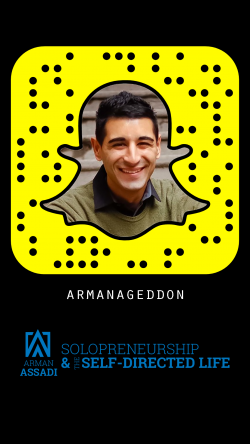Total Reading Time: 10 minutes.
Oh, Snapchat…
Are you just the latest social media app, or a pioneering multi-billion dollar platform at the forefront of digital media capturing consumer attention that’s destined for the long haul?
A lot of people say it’s the latter. Solopreneurship is exploding, and for the right influencer, brand, or company — Snapchat is the single most effective and engaging way to connect with a new or existing audience.
After some careful consideration and thinking through a list of ingredients every business needs, I decided to go “all in” on Snapchat and have been building my account while also connecting with other Snapchatters.
One of those influencers is my friend Suzanne Nguyen, known as String Story on social media. Suzanne is a “curious geek of the future that loves fried chicken, tech, and communication”. She’s also one of the most popular influencers teaching Snapchat marketing tactics.
I performed a “takeover” on her account utilizing the exact strategies she teaches (strategies that she’ll be breaking down in detail in this post). You can see the actual video from the takeover below. What is a takeover you ask?
Definition of a Snapchat Takeover: A Snapchat takeover is when a person/brand allows another user to log in and share content to the account’s public story.
Note: String agreed to share her proven, step-by-step guide on how to produce awesome Snapchat takeovers here exclusively on the blog. The entire guide below is a guest post by Suzanne Nguyen. Please make sure to:
- Download your free ebook and takeover worksheets — see form above
- Add Arman Assadi and String Story on Snapchat
- Watch the takeover video below, study the guide, and leave a comment on this post with your thoughts


Open Snapchat and take a photo of these Snapcodes OR click the image to automagically add.
Arman Assadi’s Takeover on String Story’s Snapchat Account
Introduction: Enter String…
Many have complained that Snapchat, as a closed network, is a hard channel to grow an audience. Whilst this is true, it took me just 3 months before I hit the 1k mark. Now, I realized from all the takeovers I’ve done, that it’s a hard number to reach for most people.
So, I decided to write this guide to let you digitally-pick my brain, and get some incredible results by doing Snapchat takeovers with entrepreneurs — but, without the pitfalls I’ve encountered 🙂
TL;DR: Takeovers have been a great tactic to help discover new peeps and grow my viewership
I’m super-excited to work and collaborate with you on helping YOU make the most of Snapchat Takeovers!
My role here is to act like a Producer and help you provide value to your audience. To date, I’ve successfully completed 15 takeovers (and counting!). My results so far? They’ve been overwhelmingly positive.
Sit back, and read my own notes and thoughts on how to produce awesome Snapchat Takeovers!

1) Who Is Your Audience?
Hint: It’s never about you.
Even though it’s your channel, it’s never about you, it’s about the audience and the value you provide them.
To help figure out your target audience and audit your numbers before you approach others for potential takeovers, click below.
My Snapchat Audience is made up of:
-
- Geeks, startup, tech entrepreneurs and creative entrepreneurs.
-
- Mostly men, between the age of 25-50.
-
- Australia and the United States, mainly.
-
- So far, they do enjoy takeovers because they get to discover new Snapchat Users and Content Creators.
2) Stats: Numbers You Need to Know
Most of growth came from taking over a high influencer’s Snapchat account
From the pie chart below, I was able to reach a snap view of 1000 by having regular takeovers, 23.8% have been from takeovers, which is why it’s important to use this tactic as a way for others to discover you and follow you on your Snapchat account.
Refer to Worksheet 10a (page 15) to gauge and audit you SnapChat channel.

Based on my own data and stats, here is an overview of my numbers:
-
- Avg. 18k total snap views within 24 hours (#SnapchatMonday)
- Avg. of 800-1000 per snap views
- Avg 350+ screenshots
- Avg 30 comments (#TechTuesday), it once peaked up to 87 comments.

3) Engagement
Screenshots = the new Snapchat likes

My Followers are trained to be personally engaging, now they understand the concept of screenshots. They now also incorporate screenshots in their stories to help drive user engagement.
My audience tends to want and respond better to visuals such as flow charts, lists, and schedules. For example, when Arman Assadi (@armangeddon) jumped on, his slides and giveaway images were screenshot hundreds of times.
Lately, my mind maps and flow charts (refer to image below) have been getting the most amount of screenshots.

4) Sweet Spot for Takeovers
90 – 200 seconds
(which is approximately 10-20 snaps)
From experience, to create 1.5 - 2mins of quality Snapchat content, it takes approx. 1 hour of your real time.
NB: Snapchat is not a YouTube channel: it’s best to treat with brevity - use a “keep it short and sweet” attitude. Being succinct is key.
NB2: Any content that goes over this limit will be edited by me. I’m ruthless with my quality and content! You’ve been warned! 😀
I suggest that you have the same editor type attitude too, again you like to ensure takeovers to provide value to your audience.
5) Handover (Passwords and Security)
Keep the handover process simple.
But, if you’re scared someone will steal your account, here are some ways to protect it.
Ah, the Big One! Most people are scared of someone hacking and stealing your passwords. Understandable. BUT, we have a really cool system that’s baked right into Snapchat. We’re going to talk about 2FA - or, “Two Factor Authentication”. On Snapchat it’s called Text Verification.
Here’s how to streamline and switch accounts:
- Change your password into a temporary one.
- Pick a primary form of communication (i.e. Facebook, Whatsapp, email)
- Exchange your Snapchat passwords (and second Text Verification)
- Put into your diary when you both start and finish (work out the time zones too!)
- Swap Snapcodes & preintroduce the Snapchatter beforehand.
Setting up Text Verification
NB: make sure you have a Text Verification setup beforehand!. Here’s how:
- Open Snapchat on your device.
- Tap the ghost icon at the top of your Camera screen.
- Tap the Settings gear in the top right-hand corner of your Profile screen.
- Tap ‘Login verification’ under the ‘My Account’ section.
- Tap the ‘Continue’ button.
- Tap ‘SMS’.
- Enter the verification code sent to your mobile phone and tap ‘Continue’.
- Every time you swap accounts, make sure you are on standby and exchange the second text verification codes.
6) Social X Promotion
Promote the Snapchat takeover on your social channels.

Share the news about the takeover on your various social channels. Yup, I’m looking at you Twitter, Facebook and even preintroduction on your Snapchat channel.
Leading up to your takeover, you can let people know that you’ll be on the @stringstory Snapchat channel. It’s also a good idea to tweet it out and share on Facebook during your takeover. Engagement during your takeover has a noticeable increase when you do this kind of cross-platform promotion. Give them your Snapchat GhostCode!

Providing feedback to other Snapchatters on Twitter, and having them do the same for you is a great way to cross-pollinate your audiences. Private replies on Snapchat increase your engagement with only one person at a time.
7) String’s Tips on Ultimate Takeovers
All winners! No Fillers!
-
- Have an entry snap cover (check out this snap entry cover maker)
-
- Be short and sweet.
-
- Provide value. “All winners, no fillers!” Make each snap count.
-
- Avoid follow-my-day types, you can watch this on any other Snapchatter account. The goal is to encourage the audience to follow you on your own Snapchat.
- Have fun.
-
- Remember you’re a guest on someone’s channel.
- Be yourself, but respect their differing audience demographic and culture.
- Remember you’re a guest on someone’s channel.
-
- Yes, people are known to tap away, so add text captions.
-
- Do a pre-introduction on your own Snapchat account, introducing the Snapchatter.
-
- Save your ‘stories’ before handing over the accounts back to the original owner.
8) Tips on Providing Value for Takeovers:
Here are more tips from other Snapchatters
Avery Rats: a digital Marketer based in Israel
Snapchat: AzrielR
- Give tips people can use right now.
- My general theory with content creation is that every 3 minutes a person should walk away thinking they learned at least 1 new thing, so that would definitely apply to takeovers.
- Give the people a reason right now to follow you back, like continuing the tips on your page. So in one takeover I have 5 tips for motivation and the 5th one was on my story, so they needed to follow me to get that tip.
Adam Cinemre: a digital designer based in Australia
Snapchat: AdamCinemre
- The set up – Direct people from your channel, and be sure to introduce yourself on the takeover account. Choose one (maybe 2) areas of your skill set to focus on
- The content – Come up with 1 awesomely actionable task or piece of content that will help people fall in love with you. Maybe offer a discount for your service or a tip that can help them (instill wisdom)
- The Praise – Thank them (audience/channel/host) for their attention and the opportunity to meet. “See you back over on my channel”.
Yopickles: a digital nomad known for her creativity, music, and tattoos
Snapchat: ieatpickles1111
-
- Keep it short and simple
- Interact and make it fun
- Do takeovers with people that are similar to you
Tien Wong: a CEO and VC based in Washington DC, USA
Snapchat: stienwong
- Know who your audience is and WHAT they are interested in.
- Be organized, plan your story deliberately so it flows sensibly.
- Keep it crisp – make 3 to 5 major HI IMPACT points.
- “HI IMPACT” means “substantive, meaningful and appropriate content” which the audience would greatly benefit from.
David Ma: a Cancer Researcher from Australia
Snapchat: Frostickle
- Have a strong intro which clearly explains who this new face is and why they’re there.
- Use the caption on each snap to summarize the point of that snap, this makes the entire story much easier to skim through, resulting in more viewers making it to the end. Viewers who skim quickly to the end are more satisfied than viewers who drop out halfway because they couldn’t follow the story.
- Satisfied viewers come back for more and follow takeover-ees.
9) Format Is Key
Provide value by curating high impact content with a format.
In TV production, reality and game shows have a preset structure called a “format”. I’ve found that having a format and sharing the program encourages your viewers to tune in or allow them to opt out. Refer to Worksheet 10c and 10d (page 17 and 18) to help format your Takeovers. Feel free to send the worksheet to your collaborative Snapchatter, who will be taking over your account.
String’s Suggested Takeover Format
- Introduce yourself
-
-
- Who you are
- What your areas of expertise are
- Where you are located
-
NB: here’s a challenge, try to keep your intro to a maximum of a two snap video – 20 seconds
- What’s your topic? (one snap intro)
-
- If you let the peeps know what you’re planning to do, they are more likely to stay tuned in (i.e. share a list of a program)
- Mark Suster (@msuster) is a good example, he shows the program of the week/day.

- Pick ONE style and stick with it
Below is a list of few styles to choose from
-
- Interview influencers/industry based peeps
- Tips on ‘x’ topic
- QandA format
- Review
- Tell your story about your startup/business
- Play a game
- Set up a competition
- Demo of a service or product
- Use your imagination and be creative.
- Follow my day*
- *NB. Personally, I have found this to be least engaging takeover style, so try to avoid if possible.
- Conclusion/Recap/Thank you
- Share your Snapcode
Examples of a Takeover format
Example #1
Adam Cinemre, Graphic Designer (@AdamCinemre)
Main topic: Snapchat Geofilters
- Intro who are you?
- What is a Snapchat Geofilter? (one snap response)
- Why would a business/brand use a geofilter? (share 3 benefits)
- 3 tips on how make awesome geofilters? (share some design tips)
- Show’n’Tell share cool examples of awesome geofilters
- Where can we find you and Design My Filters? (Share website/Snapcode)
Example #2
Jonathan Caras, Cofounder of Glide (@Madcapslaugh)
Main Theme: “Faster Horses, If I asked them what they wanted me to build, they would have said faster horses”
 VS
VS 
- My background working with startups
- My company and how it was founded
- How to engage and listen to your audience
- How to hear the underlying message
- How to apply this to your product
10) Instagram Story Takeover
This concept can be used to do collaborative takeovers for Instagram Stories too.
On Snapchat, you hand over your password to the collaborator to access the account. While on Instagram Stories, the host receives multiple videos or stills from the collaborator.
Snapchat has the white borders and Instagram Stories has none, making it a more seamless experience. Essentially, Instagram allows you to upload strings of content from the last 24 hours in your camera roll.
Again, takeovers can be used as a backdoor access to a new audience and demographic.
See the image below for instructions on how to upload from your camera roll on Instagram:
Step 1

Step 2

Conclusion
This course will suit anyone who wants to leverage video to build up their brand, confidence, and personality.
How will you use Snapchat going forward — and if you haven’t yet — what questions do you have?


